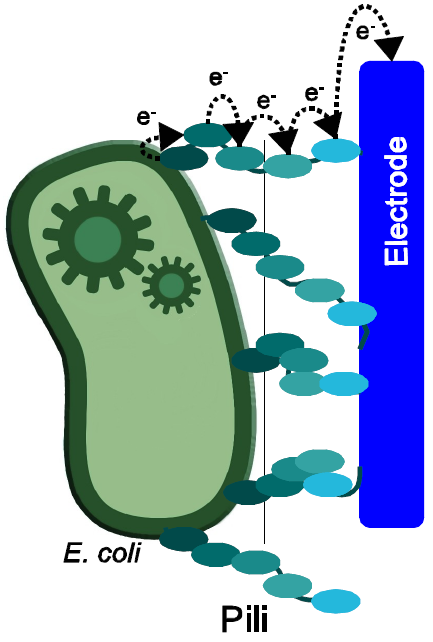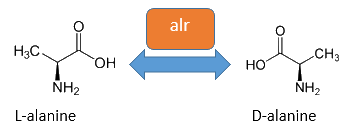Team:Bielefeld-Germany/Biosafety/Biosafety System S
From 2013.igem.org
| Line 94: | Line 94: | ||
[[File:IGEM Bielefeld 2013 biosafety araC.png]] | [[File:IGEM Bielefeld 2013 biosafety araC.png]] | ||
| - | [[ | + | ===Alanine Racemase=== |
| + | [[Image:IGEM Bielefeld 2013 biosafety alr test.png|left]] | ||
| + | <p align="justify"> | ||
| + | The alanine-racemase alr (EC 5.1.1.1) from the gram-negative enteric bacteria ''Escherichia coli'' is a racemase, which catalyses the reversible reaction from L-alanine into the enantiomer D-alanine. For this reaction the cofactor pyridoxal-5'-phosphate (PLP) is typically needed. The constitutive alanine-racemase (''alr'') is naturally responsible for the accumulation of D-Alanin, which is an essential component of the bacterial cell wall, because it is used for the crosslinkage of the peptidoglykan. The use of D-Alanin instead of a typically L-amino acids prevents the cleavage by peptdidases, but a lack of D-Alanin leeds to a bacteristatic characteristic. So in the absence of D‑Alanine dividing cells will lyse rapidly. So if the expression of the Alanin-Racemase is repressed and there is no D-Alanine-Supplementation in the media, the cells would not increase. </p> | ||
| + | <br> | ||
| + | [[Image:IGEM Bielefeld 2013 alr isomerase bearbeitet.png|600px|thumb|center|'''Figure x:''' The alanine-racemase from ''E. coli'' catalyses the reversible reaction from L-alanine to D-alanine.]] | ||
| + | |||
| + | |||
| + | <br><br> | ||
[[File:IGEM Bielefeld 2013 biosafety Terminator.png]] | [[File:IGEM Bielefeld 2013 biosafety Terminator.png]] | ||
Revision as of 21:05, 30 September 2013
Biosafety System AraCtive
Overview
The tetracyclin repressor (TetR)/ operator (TetO) originally is used by E. coli to work against the antibiotic tetracycline but in many cases it is used for regulated expression for industrial processes. When there is no tetracycline available the TetR binds with high affinity the tetracycline operator. When tetracycline is available the TetR switches his conformation and so it comes to a dissolution of the TetR and the TetO. Because of this the polymerase isn’t enhanced anymore and is able to express the genes which lies behind the TetO. In our system the TetR is under the control of a rhamnose promotor (rha-promotor) which only works in the presence of rhamnose. When the bacteria would break out of the MFC there wouldn’t be enough rhamnose in the environment to activate the promotor in a way that enough TetR would be produced to block the polymerase by binding at the TetO. Therefore the polymerase binds to the promotor of TetO and it comes to the expression of RNase Ba and the degradation of the DNA.
Genetic Approach

Alanine Racemase
The alanine-racemase alr (EC 5.1.1.1) from the gram-negative enteric bacteria Escherichia coli is a racemase, which catalyses the reversible reaction from L-alanine into the enantiomer D-alanine. For this reaction the cofactor pyridoxal-5'-phosphate (PLP) is typically needed. The constitutive alanine-racemase (alr) is naturally responsible for the accumulation of D-Alanin, which is an essential component of the bacterial cell wall, because it is used for the crosslinkage of the peptidoglykan. The use of D-Alanin instead of a typically L-amino acids prevents the cleavage by peptdidases, but a lack of D-Alanin leeds to a bacteristatic characteristic. So in the absence of D‑Alanine dividing cells will lyse rapidly. So if the expression of the Alanin-Racemase is repressed and there is no D-Alanine-Supplementation in the media, the cells would not increase.
Results
References
- Autoren (Jahr) Titel [Link|Paper Ausgabe: Seiten].
 "
"




